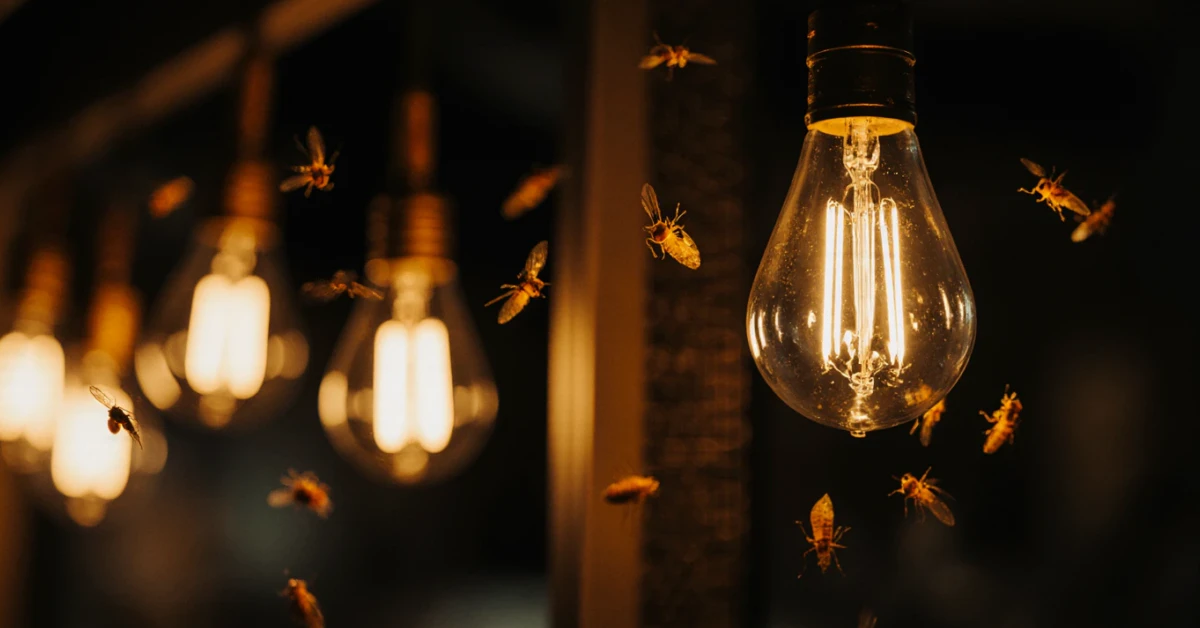If you’ve ever left a light on at night and noticed flies circling around it like tiny, persistent satellites, you’re definitely not alone.
So here’s the million-dollar question: Are flies attracted to light? Spoiler alert: yes. But not in the way most people think—and definitely not because they want to roast themselves like moths (though sometimes it sure seems like that).
Stick with me, and I’ll walk you through exactly what’s going on, the science behind it (no jargon, promise), and how you can use this info to keep those pesky houseflies where they belong—away from your dinner table.
The Real Reason Flies Circle Lights
Now, when you see a fly buzzing around your ceiling light or porch lamp, it might look like chaotic chaos. But guess what? It’s not. Scientists have actually cracked the code using advanced tracking tools and high-speed cameras. Turns out, it’s not exactly “attraction” as we’d normally think of it.
Rather than heading straight toward the light source, most flies adjust their flight path by tilting their bodies upward—what’s known as the dorsal light response. This movement is believed to be inherited from millions of years ago when bugs used sunlight and moonlight to navigate.
When an artificial light disrupts that system, they go haywire. Their instinct kicks in—”follow the top side toward the light!”—and instead of flying toward the bulb, they end up flying around it in circles. Trust me, I didn’t come up with that. You can read more about it in this deep-dive scientific study.
Doesn’t sound like the kind of behavior we’d expect from simple creatures, right?
Are All Flies Equally Drawn to Light?

You might be thinking, “Are all flies attracted to light? What about drain flies or fruit flies?”
Well, not all flies party the same way under the bulb—and here’s why:
- House flies — especially common indoors—are highly drawn to UV light, which makes them prime candidates for LED-based traps (more on that soon!).
- Drain flies, even though they hang out in wet and shady places like your drains, will still find time to buzz around lights—especially UV ones. According to Interior Fun, they may be drawn to the warmth or association with moisture-related wavelengths.
- Phorid flies — yeah, another weird name, sorry — aren’t usually thought to flock to lights compared to house or drain flies, but you’ll see them occasionally turning circles near filtered sources, especially in nighttime lab experiments.
So, nope. Different flies = different vibes under the bulb.
If you’re asking “Why are flies attracted to me?”—good question. In addition to being attracted to lights, flies are also drawn to body odors, carbon dioxide, and even sweat. So when you’re relaxing in front of the TV and get dive-bombed by a fly? It might not be personal—but it sure feels like it.
Now Let’s Talk About Blue Light
Here’s something curious.
When you google whether flies are attracted to blue light, you’ll get a ton of confused answers out there. And honestly, a lot of them just aren’t super clear.
Based on lighting research referenced in PestWest data, household insects including flies are most sensitive to UVA light—yes, also known as blacklight or close to some wavelengths found in blue LEDs. However, pure blue doesn’t always equal strong attractant power on its own. It depends entirely on the spectral output.
In short:
- Flies do respond to shorter wavelengths,
- But standard blue LED lights aren’t necessarily more effective than UV-enhanced ones.
So don’t go buying fancy Color Changing Smart Bulbs just yet unless you’re also trying to impress your cat.
What really matters? Spectrum matters more than color alone. Look for lights emitting UVA to work well as bait.
Bug Zappers – Friend or Foe?
You’ve probably seen these zappers hanging by porches, attic eaves, or bars trying to zap anything that comes near them—with an intense little CHHHRAK sound every time something gets fried.
So, are flies attracted to bug zappers? The short answer is—yes, many flies are lured by them.
How? Because zappers emit UV light designed to mimic moonlight and stars. And remember how flies navigate using celestial cues? Yep, that same trick gets activated even in our modern world.
But here’s a big catch:
- Zappers bring in both helpful and unhelpful bugs,
- You might end up killing beneficial moths, beetles, or midges along the way—especially in rural settings,
- They work best in open areas free from competing UV light pollution.
Bottom line: Bug zappers help — but only to a point. For total control, combine them with targeted hygiene practices and modern light-trapping units specifically calibrated for fly capture zones like entryways or dining rooms.
Got a Frantic Fruit Fly Infestation? Consider Vinegar Too
Here’s a fun twist you didn’t expect right? If you’re wondering are flies attracted to vinegar, you’re onto something big. Particularly fruit flies.
Fruit flies adore fermenting sugars—and vinegar just happens to spill off sweet and sour smells at full throttle.
This is why DIY traps involving apple cider vinegar are infamous for trapping them like low-tech honey pots. Pop a funnel lid over a jar, and voila, bye-bye babies.
Best part? No zapping required. Just manual cleanup and disposal.
That said—vinegar won’t do much for regular houseflies or those persistent drain dwellers. So keep expectations realistic: one-size-fits-none.
A Little Help From Nature: What Attracts Flies – Naturally
Okay let’s take a step back.
Besides light, what else draws our furry-winged roommates inside? It helps to know, so we can catch problems early before they explode:
- Poop? Oh yes. Why are flies attracted to poop? Simple: Fresh fecal matter creates breeding grounds for maggots. Mammals aren’t the only ones who appreciate nutrients—insects sure love ’em too.
- Rotten Food — Throwaway banana peels? Crumbs hidden under the couch? These are early magnets for larger fly species looking to lay eggs nearby.
- Garbage Bins — If lids aren’t sealed tight? Open invitation city for unwanted guests.
- Wet Pet Bowls — Pet owners beware! Especially after your dog’s kibble turns soggy overnight and starts giving off odors some consider irresistible.
You’d be surprised how quickly a neglected dish becomes a mini hotel suite for buzzing new arrivals.
Can You Outsmart a Fly Without Turning Off All Your Lights?
Let’s face it: modern life means staying visible after dark. But does that mean turning everything off just to keep flies away?
Nope.
We can tweak a few things to repel unwanted winged visitors effectively while keeping your decorated aesthetic intact:
1. Switch to Low-UV Bulbs
Start swapping your outdated incandescent or cheap white LEDs with low-UV alternatives. Compact fluorescents and certain premium L.E.D.s reduce appeal significantly by removing excess UV exposure which drives attraction across multiple species.
2. Direct Bulb Positioning Strategically
You may want light near entrances to spotantsy potential intruders—but too much illumination beyond a room’s normal ambient brightness can trigger an involuntary aerial invasion. Keep exits just lit enough for safety, nothing unnecessarily intense.
3. Clean Up Common Fly Hotspots Regularly
The golden rule nobody tells you but every exterminator swears by?
Cleanliness + removal of moisture + elimination of easy egg-laying zones = fewer flies buzzing towards any lights at all, period.
Wrapping Up With Warmth
Flies and lights have a complicated relationship—one full of misguided navigation instincts, UV temptations, ancestral behaviors borrowed straight from cave men days, and unfortunately still staying relevant today.
You’ve hopefully walked away not just seeing bugs around lights with greater awareness now—but with strategies to deal with them gently, efficiently, and simply.
Say goodbye to frantic vacuums underneath soffits and welcome proactive pest awareness for cleaner living areas—and oh yeah, uninterrupted TV watching without unwanted pests dropping onto shoulders!
I know dealing with pests sometimes feels like being overwhelmed by forces beyond control. But trust—it’s simpler than you think, and knowing what’s behind these noisy dance-offs beneath the light switch gives you more power than ever to fix it.
Got a quirky fly story of your own? Was it watching bulbs torture your 9pm naps or disrupting dinner plans unexpectedly?
Drop your tales below—we love this stuff.


















Leave a Reply
You must be logged in to post a comment.